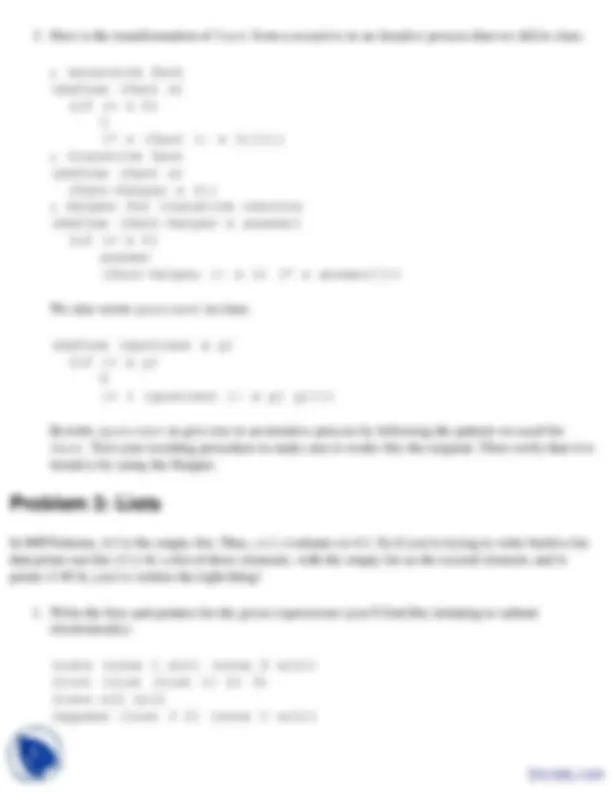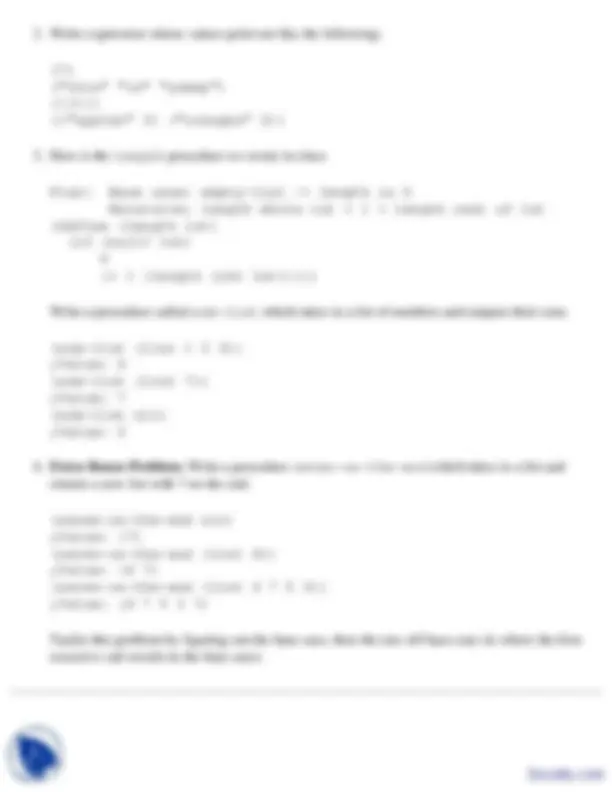




Study with the several resources on Docsity

Earn points by helping other students or get them with a premium plan


Prepare for your exams
Study with the several resources on Docsity

Earn points to download
Earn points by helping other students or get them with a premium plan
Community
Ask the community for help and clear up your study doubts
Discover the best universities in your country according to Docsity users
Free resources
Download our free guides on studying techniques, anxiety management strategies, and thesis advice from Docsity tutors
Some concept of Building Programming Experience are Evaluation, List Procedures, Experience Modifying, Non-Collaborative, Syntactic Sugar, Thesaurus.Main points of this homework are: Syntactic Sugar, Check, Recursive, Iterative Processes, Definitions, Stepper, Computation Unfolds, Evaluation, Process, Evaluate
Typology: Exercises
1 / 4

This page cannot be seen from the preview
Don't miss anything!



(define (foo x) (+ x 5)) (let ((x 1)) x) (let ((foo (= x 1)) (bar 7)) (if foo bar #f)) (define (weird x y z) ; this one's odd (lambda (foo) (+ x y z foo)))
(define x 5) (define (y) (+ 7 7)) (let ((x 3)) (+ x x)) (let ((x (y)) (y 7)) (if (> x 3) 7 y) (let ((mit 12)) (let ((is (+ mit 1))) (let ((hard (- is 7)))
(+ mit is hard))))
(define (remainder x y) (if (< x y) x (remainder (- x y) y))) (define (fact n) (if (= n 0) 1 (* n (fact (- n 1)))))
Then evaluate (fact 10) with the Stepper (use M-s instead of C-x,C-e). Hold down the space bar and watch how the computation unfolds. How would you describe the text as a whole as it does the evaluation? How indented is it? What does the end (you can use M-> to go to the end of a buffer) look like? Is there a point at which the process of evaluation changes? Keep in mind that the stepper indents two spaces when it is trying to evaluate a subexpression.
Pop back to scheme and evaluate (remainder 30 3) with the Stepper (again, M-s). Hold down the space bar again. How is this computation different? What does the end look like?
Explain these differences with reference to recursive vs iterative processes. (You need not submit the Stepper buffers you produce)
(define (slow-add1 a b) (if (= a 0) b (inc (slow-add1 (dec a) b)))) (define (slow-add2 a b) (if (= a 0) b (slow-add2 (dec a) (inc b))))
For each procedure, indicate whether it gives rise to a recursive or iterative process, and why. Then test it with the stepper to verify your hypothesis (you need not submit the Stepper buffer that you produce).
("this" "is" "yummy") ((())) (("apples" 3) ("oranges" 2))
Plan: Base case: empty-list -> length is 0 Recursive: length whole lst = 1 + length rest of lst (define (length lst) (if (null? lst) 0 (+ 1 (length (cdr lst)))))
Write a procedure called sum-list which takes in a list of numbers and outputs their sum.
(sum-list (list 1 2 3)) ;Value: 6 (sum-list (list 7)) ;Value: 7 (sum-list nil) ;Value: 0
(seven-on-the-end nil) ;Value: (7) (seven-on-the-end (list 4)) ;Value: (4 7) (seven-on-the-end (list 4 7 5 3)) ;Value: (4 7 5 3 7)
Tackle this problem by figuring out the base case, then the one-off base case (ie where the first recursive call results in the base case).